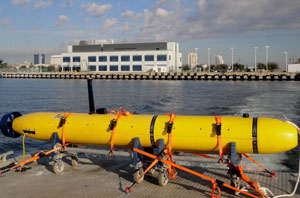SRI St. Petersburg is accelerating technology R&D in ocean science, marine technology and port security with cutting-edge technologies that have applications far beyond these realms.
Experts in chemical sensing, optical imaging and engineering, the group specializes in the study of surface and subsurface marine environments. Among the high-performance chemical sensors being developed here are miniature mass spectrometers that measure and trace volatile organic compounds and dissolved gasses. While they have wide-ranging applications, these instruments are capable of “sniffing out” explosives, drugs or contraband attached to the hulls of ships entering ports that would otherwise be practically impossible to discover.
Mass spectrometers can be deployed on a variety of platforms, including remotely operated or autonomous underwater vehicles (ROVs and AUVs), in tandem with sonar and cameras that can rapidly scan underwater environments and produce 3D photo images. They can scan and image 3,000 linear feet of seawall in about 20 minutes, “something that would probably take a team of 10 divers at least a full day to do,” says SRI St. Petersburg Director Larry Langebrake, “and at the end of the day they would have no images, no information to compare it to. This technology is a huge multiplier.”

It’s just one facet of a larger port and maritime security data-gathering and information management system SRI has developed that provides a simplified view of complex port operations and activities. The system already is operating in several undisclosed ports across the U.S.
In fact, a key reason SRI has been so successful in so many realms is its focus on commercializing technologies. “So we’re looking at that constantly, and there are three or four technologies on the conveyor belt that have generated various levels of interest,” says Langebrake.
For instance, SEAS, SRI’s compact spectrophotometer that can measure chemical constituents in the parts per trillion to depths of more than 3,000 feet might be adapted for measuring surface nutrient runoff in places like the Great Lakes, where agricultural runoff is blamed for causing the worst algal bloom in decades. The technology could be used to provide feedback to farmers and for regulatory enforcement.
“That’s not yet on the conveyor belt but it’s an example of one that could be in the near future because of how well it could potentially address this problem,” Langebrake says.
Business continues to grow in the areas of homeland security and defense, educational training, and environmental research, as well as space exploration, he adds.
NASA recently funded SRI to determine how miniaturized mass spectrometer systems might be adapted and deployed in space. “It could be used for upper atmospheric research – trying to understand what’s happening with solar flares and space weather, or flying it through the tail of a comet to analyze its chemical constituents.” SRI is also applying its expertise to technology that may eventually travel to Mars in a separate project with NASA’s Goddard Space Center,
In addition to its St. Petersburg facility, SRI has a microelectromechanical (MEMS) lab in Largo where it designs and fabricates nano- and micro-scale devices for applications including marine and weather sensing.
[su_divider] Originally published Winter 2013